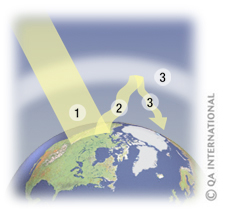
Pollution, throwing the natural environment off balance
Of all living things, humans have the most impact on their environment. They change their habitat to suit their needs, more so than most other species. When a growing population finds there are fewer resources than before, it responds by expanding cities and farmland, throwing the natural environment off balance. Many human activities that relate to agriculture, transportation, and industry create different kinds of pollution. Whether they are released into the water, the air, or the ground, pollutants waste no time spreading throughout an ecosystem. The planet’s health and future depend on the willingness not just of individuals, but governments around the world, to fight the causes of pollution and to work hand in hand to prevent it.
Water pollution
The planet’s water reserves are constantly polluted by waste from agriculture, industries, and sewers. Since water is always circulating through the environment, it transports the pollutants it contains from one area to the next. A pesticide that is sprayed on a field, for example, seeps into the groundwater, finds its way to a stream, and finally ends up in the ocean. These toxic substances harm aquatic plants and animals, and also infect the food chain, causing certain plant and animal species to become extinct. They can also contaminate humans who eat fish. Even though dumping garbage in the ocean is strictly forbidden, many countries release their untreated sewer waste and dispose of their garbage into the water. In addition to this, more than 6 million tons of oil are accidentally spilled into the ocean every year.
Ground pollution
Every year, millions of tons of industrial waste, household garbage, fertilizer, and pesticides are dumped into nature. Many of these substances are not biodegradable, which means that microorganisms in the ground cannot break them down. Things like metal cans, glass, and most plastics accumulate in the environment. That is why it is important to recycle and to reuse things instead of throwing them out. Most nonbiodegradable pollutants in the ground come from industries, which emit thousands of different substances. Some of these are highly toxic chemicals that seep into the ground and contaminate watercourses. In spite of efforts to regulate garbage disposal and farming practices, countries around the world are continuing to contaminate more and more of their soil.
In industrialized countries, the average family produces almost two tons of garbage a year. More than half of that garbage comes from paper packaging, metal, glass, and plastic that can be recycled or reused. Almost a quarter of household garbage is kitchen waste like vegetable peels. This kind of garbage can be turned into compost, a natural fertilizer that can be used to enrich the soil of gardens or cultivated fields.
Air pollution
Many human activities over the last 200 years have been responsible for polluting the air and damaging people’s health. Automobile engines and power plants burn combustible fuels like gasoline and coal and allow toxic gases and smoke to escape into the air. Some pollutants help destroy the ozone layer, which is the thin blanket of gases that protects Earth from the Sun’s dangerous ultraviolet rays. Other pollutants contribute to global warming by adding to the planet’s natural greenhouse effect. Still others help to create acid rain, a phenomenon that has disastrous effects on lake and forest habitats. Air pollution is not limited to industrial areas. Depending on the direction of the wind and its force, air pollutants may even spread to other countries very far from the source of the pollution.
Big cities like Los Angeles and Mexico City are often covered by smog, a fog that occurs because of air pollution. In 1952, the city of London, England, was enveloped by smog so thick that people on the streets had to feel their way around by touching the walls of buildings!
Earth: A giant greenhouse
Methane, CFCs (chlorofluorocarbons), and nitrous oxide form a belt of gases around Earth. This mixture of gases is responsible for a phenomenon called the greenhouse effect. Without this natural greenhouse effect, weather on our planet would be much cooler than it is now.

1- The Sun’s rays hit Earth, causing it to heat up.
2- Earth releases some of its heat into the atmosphere.
3- Greenhouse gases trap the heat and keep it close to Earth’s surface. This is known as the greenhouse effect.
Human activities like farming and the cutting of trees, along with pollution, produce a large amount of greenhouse gases. Meteorologists fear that these gases dramatically add to Earth’s natural greenhouse effect and increase global warming. This imbalance in the world’s climate can cause flooding, hurricanes, and shortages of rain in some areas.
Everyone must make an effort to save energy, avoid waste, and use low-pollution forms of transportation such as bicycles, electric cars, and carpooling. Even though the quality of our air has improved in the last 30 years, there is still much work to be done.
Also see:
In the Visual Dictionary:
- "environment" section
In the encyclopedic capsules:
In the ikonet games:
- Put it in its place!: land pollution




